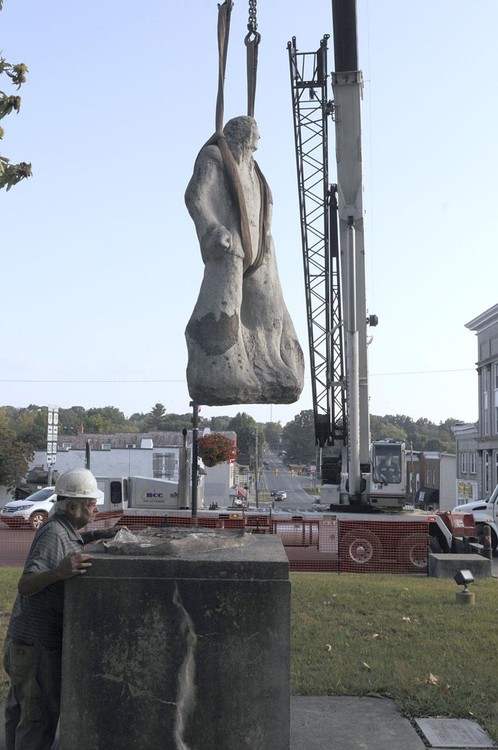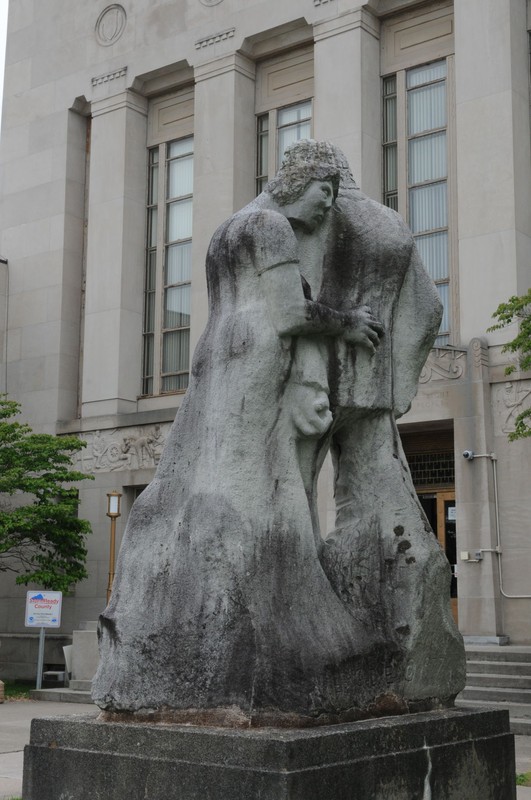Agony In Stone Statue
Introduction
Text-to-speech Audio
Images
Statue Being Relocated

Agony in Stone Statue

Backstory and Context
Text-to-speech Audio
Native Americans and European Settlers
European settlers continued to move into the United States and took over more and more land from the Native Americans. Native Americans had no concept of private land ownership and deeds to a property because all they had ever known was a communal style of living. Whenever European settlers began moving further onto their land and claiming ownership, it caused many violent reactions like the French and Indian War in 1754, Pontiac’s War in 1763, the Battle of Point Pleasant in 1774, the Revolutionary War in 1777, and even the attack on the Clay family in 1774.
Family History
The Clays acquired and claimed 800 acres of land near Bluestone Creek in 1774. This was deeded to them by the previous owner John Draper, but this "white man's deed" meant nothing to the Shawnee Indians who were the original landowners. The Shawnee Indians believed this was their land and saw a white family settling on their property without making a deal with them. In 1783 they decided to take matters into their own hands. One day while Mitchell Clay, the head of the family, was hunting the Shawnee Indians attacked the other family members while they were doing their chores. They killed two of Mitchell and his wife Phoebe's children while their other children fled. The names of the two that were killed were Bartley and Tabitha. Bartley was shot and killed on the spot and Tabitha was scalped trying to run to her brother's rescue. While fleeing from the scene, the Shawnees also took Ezekiel Clay captive. When Mitchell heard of the news, he gathered a team and went to look for Ezekiel but found him already burned to death. Instead of retaliating, Mitchell desired to grant his son a proper burial. He made a deal with the Shawnee Indian Chief, and this ended the dispute altogether.
Statue
The Statue was built in 1977 in honor of this family who endured tragic loss. The Clays are also credited to be the first to settle in what is now called Mercer County. This statue was built as a reminder of the story of the county's first settlers.
The statue was originally located on Court House road in the center of Princeton. In August of 2019 it had to be moved due to a ramp installment for the Courthouse. Today the Statue is located close to a well-visited attraction site, Lake Shawnee. This placement was chosen strategically to ensure the couple overlooked their former land.
Sources
Coppola, Emily D. "Historic Statue Survives Move to New Location." Bluefield Daily Telegraph, 22 Sept. 2019, www.bdtonline.com/news/historic-statue-survives-move-to-new-location/article_20edcee8-dcd6-11e9-88c5-8b319ad84e6c.html#utm_campaign=blox&utm_source=facebook&utm_medium=social.
Coppola, Emily. "‘Agony in Stone' Statue at Courthouse Depicts Sombre History." Bluefield Daily Telegraph, 7 June 2019, www.ptonline.net/community/agony-in-stone-statue-at-courthouse-depicts-sombre-history/article_33132ce6-892d-11e9-b110-f399be221627.html.
Toler, Tammie. "Historians Save Clay Family Memories for Community." Princeton Times, 2 July 2010, www.ptonline.net/news/local_news/historians-save-clay-family-memories-for-community/article_515b5a19-542a-5b43-8e61-065efa7fcc88.html.
“Native American Clashes with European Settlers.” West Virginia Department of Arts, Culture, and History, West Virginia Archives and History, http://www.wvculture.org/history/archives/indians/indland.html.
